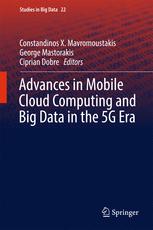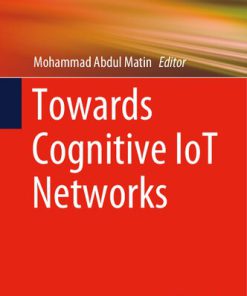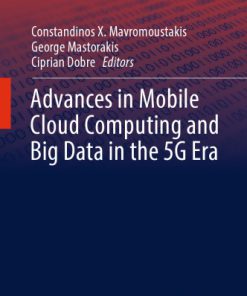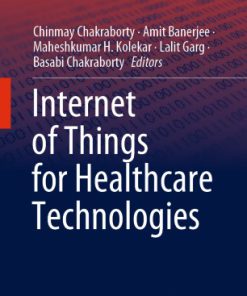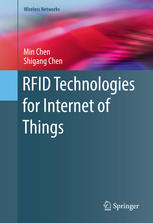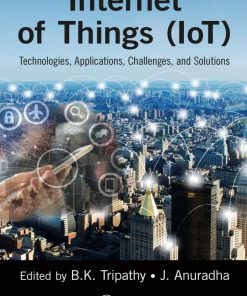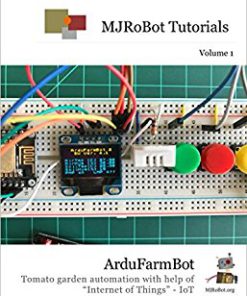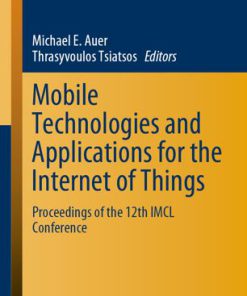Internet of Things IoT in 5G Mobile Technologies 1st Edition by Constandinos Mavromoustakis, George Mastorakis, Jordi Mongay Batalla ISBN 9783319309132 3319309137
$50.00 Original price was: $50.00.$25.00Current price is: $25.00.
Internet of Things IoT in 5G Mobile Technologies 1st Edition by Constandinos Mavromoustakis, George Mastorakis, Jordi Mongay Batalla – Ebook PDF Instant Download/Delivery: 9783319309132 ,3319309137
Full download Internet of Things IoT in 5G Mobile Technologies 1st Edition after payment
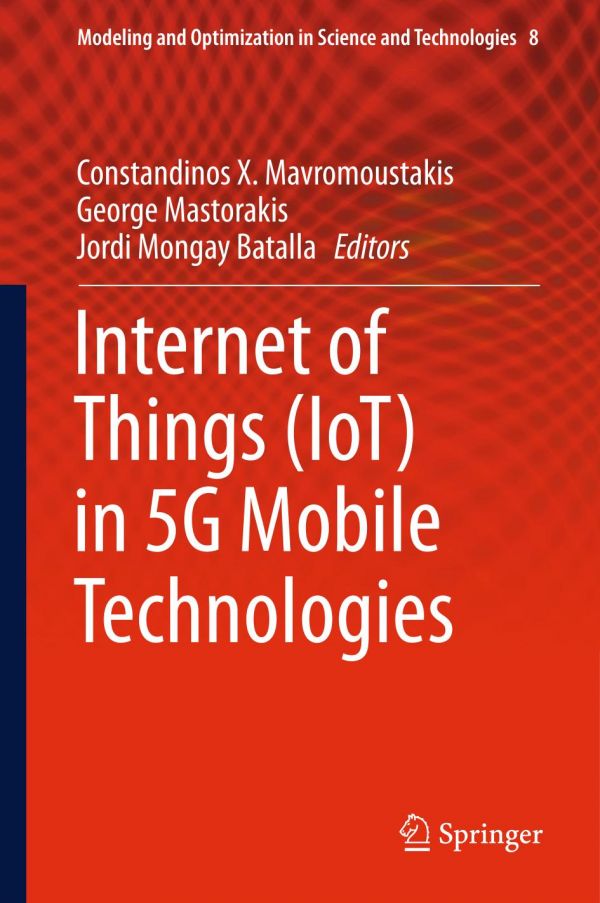
Product details:
ISBN 10: 3319309137
ISBN 13: 9783319309132
Author: Constandinos Mavromoustakis, George Mastorakis, Jordi Mongay Batalla
Internet of Things IoT in 5G Mobile Technologies 1st Edition Table of contents:
Part I IoT Resource Management in Application Domains
1 Towards the Usage of CCN for IoT Networks
1 Introduction
2 The Internet-of-Things (IoT) World
2.1 Smart City
2.2 Smart Home
2.3 Vehicles/Automotive Applications
2.4 Healthcare/Telemedicine/Wearable Applications
2.5 Sports & Leisure
3 Introduction to CCN (Content-Centric Networking)
4 Technical Challenges for IoT and CCN Advantages
4.1 Configuration and Scalability
4.2 Efficiency
4.3 Quality of Service
4.4 Functionalities on Heterogeneous Devices
4.5 Architecture
4.6 Mobility
4.7 Migration/Interconnection
5 Use-Case: Retrieval of Physical Objects in Smart Cities
5.1 Scenario of the Use-Case
5.2 Networking Architecture
5.3 CCN-Based IoT Sensors
5.4 IP/CCN Gateway
5.5 Protocols
5.6 Call Flow
5.7 Graphical User Interface
6 Conclusion
References
2 On the Track of 5G Radio Access Network for IoT Wireless Spectrum Sharing in Device Positioning Ap
Abstract
1 Introduction
2 Requirements for Users’ Data Collection System
3 Big Data Platform and Computational Algorithms
4 Wireless Access
5 Summary and Conclusions
Acknowledgments
References
Millimetre Wave Communication for 5G IoT Applications
1 Introduction
2 Millimetre Wave Channel
3 Millimetre Wave Modulation
3.1 OFDM
3.2 FBMC
3.3 UFMC
3.4 SC
3.5 Evaluation
4 Millimetre Wave Channel Coding
4.1 Requirements for 5G
5 Millimetre Wave MIMO
5.1 Spatial Multiplexing
5.2 Beam Forming
5.3 Evaluation
6 Conclusions
7 Future Research Directions
References
4 Challenges Implementing Internet of Things (IoT) Using Cognitive Radio Capabilities in 5G Mobile N
Abstract
1 Introduction
2 Smart Environments in 5G Wireless Networks
2.1 Defining Smart Environments
2.2 Smart Environment Architectures and Applications
3 Smart Environment Resources
4 Cognitive Radio Networks and Platforms
4.1 Cognitive Radio Definition
4.2 CR Platforms and Testbeds
5 Current Standards and Application Scenarios
5.1 Indoor Smart Environments
5.2 Outdoor/Long-Range Smart Environments
5.3 IoT and Cognitive Radio Applications
6 Research Challenges in Resource Management for IoT in 5G Mobile Networks
7 Conclusions
References
Role Coordination in Large-Scale and Highly-Dense Internet-of-Things
1 Introduction
2 Related Work
2.1 Sensing and Relaying
2.2 Data-Control (Aggregation and Replication)
2.3 Data-Fusion for Event-Detection
2.4 Role Coordination Frameworks
2.5 Related Work Summary
3 Framework for Role Coordination in Large-Scale and Highly-Dense IoT Scenarios
3.1 Applications, Requirements and Objectives
3.2 Architecture Overview
3.3 Task 1: Sensing, Individual Detection, and Collection of Auxiliary Data
3.4 Task 2: Agreement on Detection and Event Criticality Level
3.5 Task 3: Data-Control Strategies Decision
3.6 Task 4: Tree and Relay Selection
4 Discussion
4.1 Illustration
4.2 Qualitative Comparison
5 Conclusion
References
Energy Harvesting and Sustainable M2M Communication in 5G Mobile Technologies
1 Introduction
2 Perpetual Operation of IoT
2.1 Ambient Energy Harvesting Solution for Low Power Devices
2.2 Dedicated RF Energy Transfer to Meet High Power Requirements
2.3 Analytical Characterization of Wireless RF Charging Process
3 Strategies for Improving RF Energy Transfer Efficiency
3.1 Limitations of Conventional RF Energy Transfer Technology
3.2 Multi-path Energy Routing
3.3 Optimal Energy Relay Placement in Two Hop RFET
3.4 Beamforming Techniques
3.5 Network Level Strategies
3.6 A Case Study: Networking Consequence of Smart RF Harvesting Communications
4 Wireless Powered Communication Networks
4.1 State-of-the-Art Research
4.2 RF-Powered M2M Communications
5 Future Research Directions and Opportunities
5.1 Joint Information and Energy Transfer
5.2 Relay Assisted M2M Communication
5.3 Software Defined Radio Aided M2M Communication
6 Conclusion
References
Part II Applications of IoT in 5G Access Technologies
Green 5G Femtocells for Supporting Indoor Generated IoT Traffic
1 Introduction
2 Overview of Femtocell Networks
3 System Model
3.1 Channel Model
3.2 Calculation of the Data Rates
4 Network Utility Maximization
4.1 Problem Formulation
4.2 Utility Selection
5 Centralized RRM Algorithm
6 Green FAP Switching Algorithm
7 Results and Discussion
7.1 Results of Centralized RRM with All the FAPs Active
7.2 Results of the Green Network Operation with FAP On/Off Switching
8 Conclusions
References
8 On the Research and Development of Social Internet of Things
Abstract
1 Introduction
2 From IoT to SIoT
3 Advantages of SIoT
3.1 Navigability
3.2 Flexibility
3.3 Trustworthiness
4 SIoT Challenges
4.1 Heterogeneous Devices
4.2 Data Handling and Management
4.3 Energy Consumption Management
4.4 Security, Trust, and Privacy
4.5 Resilience to Faults
5 Some Recent Developments
5.1 Human Behavior
5.2 Network Navigability
5.3 Key Aspects of Network Navigability
6 Scope for Future Work
7 Conclusions
References
Microgrid State Estimation Using the IoT with 5G Technology
1 Introduction
1.1 Related Research
1.2 Contributions
2 Architecture and Vision of the IoT
3 Evolution Path of Communication Standards
4 A Potential 5G Architecture, Visions, Challenges and Design Principles
5 Microgrid
5.1 Mathematical Dynamic Model of the DER
5.2 Discretisation of the DER State-Space Model
6 Proposed 5G Communication Systems
7 Proposed Distributed State Estimation Using the IoT with 5G Networks
8 Simulation Results and Discussions
9 Conclusions
References
Building IoT Ecosystems from Mobile Clouds at Network Edge
1 Overview of Io* Technologies
2 IoT: Internet of Things
3 IoV: Internet of Vehicles
4 IoE: Internet of Everything
5 Cloudification of Io* Technologies
6 Parallel Connectivity and Mobile Clouds
6.1 Mobile Clouds
6.2 4G+ Technologies
6.3 Multi- and GroupConnect
6.4 Wireless Connectivity Virtualization
6.5 Practical Advantages of Mobile Clouds
7 A Cloud-Based IoT Stack
7.1 Device Virtualization
7.2 Device Cloudification
7.3 Cloud Boxes: from DCs to Edge Devices
8 Example IoT Clouds
8.1 Cloud-Based Video Streaming
8.2 Vehicular Clouds as DC Extentions
8.3 Vehicular Clouds with Beacons
9 Summary and Future Directions
References
Part III Architecture of IoT and Related Technologies
11 Middleware Platform for Mobile Crowd-Sensing Applications Using HTML5 APIs and Web Technologies
Abstract
1 Introduction
2 Crowdsensing Architectures
3 Related Technologies
3.1 HTML5
3.1.1 Overview
3.1.2 HTML5 APIs
3.2 Google Services
3.2.1 Google Maps and Google Maps API v3
3.2.2 Google Geocoding API v3
3.2.3 Geo-fence
3.3 Meteor Platform
3.4 JavaScript-Based Technologies
3.4.1 JSON
3.4.2 BSON
3.4.3 GeoJSON
3.4.4 Ext JS Framework
3.5 X3D and X3Dom
4 Platform Architecture
4.1 Components
4.1.1 Client Component
4.1.2 Server Component
4.1.3 3rd Party Component
5 Demostration and Implementation Scenarios
5.1 The Client Component
5.1.1 Data Measurement and Data Conversion Module
5.1.2 Data Insertion Module
5.1.3 Distance Calculator
5.1.4 Geofence Functionality
5.1.5 Real-time Live Users
5.2 The Server Component
5.2.1 Reverse Geocoding Job
5.2.2 NoiseTube Request Job
5.2.3 History Record Jobs
5.2.4 Clean and Record Generator Jobs
5.2.5 Time Aggregation Job
5.2.6 Hourly Job
5.2.7 Daily—Monthly—Yearly Job
5.3 The 3rd Party Component
5.3.1 Access Data API
5.3.2 Dynamic Map and Data Uploading Module
5.3.3 Real-Time Map
5.3.4 Ticketing Functionality
5.3.5 Historical Map
5.3.6 Charts by Time
5.3.7 Averages 2D sim Ext JS by Country
5.3.8 Averages 3D sim X3Dom by Country
6 Privacy
6.1 Introduction
6.2 Anonymization
6.3 Encryption
6.4 Data Perturbation
7 Motivation—User Incentives
7.1 Introduction
7.2 Gamification
7.3 Gamification in Crowdsensing
7.4 Noise Pollution Puzzles
8 Conclusion and Future Work
References
12 Identification and Access to Objects and Services in the IoT Environment
Abstract
1 Introduction
2 Current Technologies for IoT Naming
2.1 IPv6 Addressing
2.2 EPC
2.3 Ucode
2.4 HIP
3 Solutions Proposed by Research Projects
3.1 OpenIoT
3.2 IoT@Work
3.3 iCORE
3.4 VIRO
3.5 MobilityFirst
3.6 IDSECOM
4 Research and Future Development Trends and Forecast
5 Summary and Conclusions
Acknowledgments
References
13 A Generic and Scalable IoT Data Fusion Infrastructure
Abstract
1 Introduction
2 Basic Principles: Contextors and Algorithms
3 The Fusion Box Architecture
3.1 The Network Module
3.2 The Configuration Module
3.3 The Data Processing Engine
3.4 The Fusion Box Expert User Interface
4 The Data Processing Workflow Description Language
4.1 An Example DPW Script: Detection of a Fire Event
5 The Fusion Box Ecosystem
6 Conclusions and Platform Extensions
Acknowledgments
References
ONSIDE-SELF: A Selfish Node Detection and Incentive Mechanism for Opportunistic Dissemination
1 Introduction
2 Related Work
3 Data Dissemination in Opportunistic Networks (ONSIDE)
4 Selfishness in Opportunistic Routing (SENSE)
5 ONSIDE-SELF
6 Experimental Results
6.1 Experimental Setup
6.2 Results
7 Conclusions
References
Middleware Technology for IoT Systems: Challenges and Perspectives Toward 5G
1 Introduction
2 Middleware Technology for IoT Systems
2.1 IoT Ecosystem Overview
2.2 Horizontal Architecture Approach for IoT Systems
2.3 SOA-based IoT Middleware
3 Challenges Introduced by 5G in IoT Middleware
3.1 Technological Requirements of 5G Systems
3.2 5G-based IoT Services and Applications Requirements
3.3 5G-based Challenges for IoT Middleware
4 Perspectives and a Middleware Approach Toward 5G
4.1 COMPaaS Middleware
5 Related Work
5.1 Internet of Things Projects
5.2 Interoperability and Scalability
5.3 Addressing and Naming
5.4 Data Management
5.5 Context of Things
5.6 Security and Privacy
6 Summary
References
Part IV Security Considerations in IoT Smart Ambient Systems
16 Security in Smart Grids and Smart Spaces for Smooth IoT Deployment in 5G
Abstract
1 5G and the Internet of Things
2 Smart Spaces
3 Smart Grids
4 Security and Privacy
5 Services that Need to Be Secure
5.1 Data Collection
5.2 Control Messages
5.3 Equipment Monitoring
5.4 Notification Transmission
6 Security Requirements
6.1 Confidentiality
6.2 Integrity
6.3 Availability
6.4 Authentication
6.5 Nonrepudiation
6.6 Access Control
7 Security Attacks
7.1 Passive Attacks
7.1.1 Release of Message Contents
7.1.2 Traffic Analysis
7.2 Active Attacks
7.2.1 Denial of Service
7.2.2 Jamming
7.2.3 False Data Injection (FDI)
7.2.4 Masquerade
8 Security Measures and Ongoing Research
8.1 Securing Smart Spaces and Smart Grids
8.2 Ongoing Research
8.2.1 Flocking-Based Model Against DoS Attacks
8.2.2 Warning System Against Malicious Events
8.2.3 Jamming Attack Detection Based on Estimation (JADE)
8.2.4 Smart Tracking Firewall
8.2.5 Cryptographic Keys in the Internet of Things
8.2.6 Real-Time Detection of False Data Injection Scheme
8.2.7 Minimizing Message Delay Under Jamming Conditions
8.2.8 Privacy in Smart Grids Using Aggregated Key Encryption
8.2.9 False Data Injection Detection in Smart Grids
8.2.10 Intrusion Detection in NANs
8.3 Current Issues and Challenges
8.4 Scheme Proposition for Data Retrieval After an FDI Attack
References
Security Challenges in 5G-Based IoT Middleware Systems
1 Introduction
2 5G and the Internet of Things
2.1 5G Technology
2.2 Internet of Things
3 Security in 5G-Based IoT Middleware
3.1 New Threats and Requirements
4 Related Work
5 Security Challenges Toward 5G
5.1 User Privacy and Data Protection
5.2 Big Data Security and Lightweight Approaches
5.3 Devices and Applications Protection
5.4 Communication Channels Protection
5.5 Standard Security Architecture
6 Summary
References
Signal Processing Techniques for Energy Efficiency, Security, and Reliability in the IoT Domain
1 Introduction
2 Compressive Sensing
3 Matrix Completion
4 Secret Key Generation from Channel Measurements
4.1 Key Generation
4.2 Performance Evaluation
5 Packet Loss Mitigation
5.1 Compressive Sensing for the Intra-temporal Correlation
5.2 Matrix Completion for the Inter-spatial Correlation
6 Adaptive Compressive Sensing
6.1 Change Point Method Based on KS Statistic
7 Rate-Adaptive CS Under a CPM Framework
7.1 CS Compression and Decompression
7.2 Measurement Matrix Design
7.3 Sparsity Change Detection and Estimation
7.4 Evaluation
8 A Software Defined Radio Architecture for IoT Applications
8.1 Physical Layer Implementation
8.2 MAC Layer Integration
8.3 An IoT Prototype Application
9 Conclusions
References
IoT Enablers and Their Security and Privacy Issues
1 Introduction
2 IoT Enabler
2.1 Technological Framework
2.2 Data Security Framework
2.3 Legal Framework
3 EPCglobal
3.1 Architecture
3.2 Specifications
3.3 Industry Adoption
3.4 Security Features and Vulnerabilities
3.5 Guidelines/Framework for Managing Data
3.6 Proposed Upgrades
3.7 Advantages and Drawbacks
4 WirelessHART
4.1 Architecture
4.2 Specifications
4.3 Industry Adoption
4.4 Security Features and Vulnerabilities
4.5 Guidelines/Framework for Managing Data
4.6 Proposed Upgrades
4.7 Advantages and Drawbacks
5 Zigbee
5.1 Architecture
5.2 Specifications
5.3 Industry Adoption
5.4 Security Features and Vulnerabilities
5.5 Guidelines/Framework for Managing Data
5.6 Proposed Upgrades
5.7 Advantages and Drawbacks
6 Near Field Communication
6.1 Architecture
6.2 Specifications
6.3 Industry Adoption
6.4 Security Features and Vulnerabilities
6.5 Guidelines/Framework for Managing Data
6.6 Proposed Upgrades
6.7 Advantages and Drawbacks
7 6LoWPAN
7.1 Architecture
7.2 Specifications
7.3 Industry Adoption
7.4 Security Features and Vulnerabilities
7.5 Guidelines/Framework for Managing Data
7.6 Proposed Upgrades
7.7 Advantages and Drawbacks
8 Dash7
8.1 Architecture
8.2 Specifications
8.3 Industry Adoption
8.4 Security Features and Vulnerabilities
8.5 Guidelines/Framework for Managing Data
8.6 Proposed Upgrades
8.7 Advantages and Drawbacks
9 Comparative Analysis
10 Conclusion
References
Part V IoT Systems for 5G Environments
20 Data and Traffic Models in 5G Network
Abstract
1 Introduction
2 State of the Art
3 Experiment Setup
4 Results
5 Conclusion and Future Work Plan
Acknowledgments
References
People also search for Internet of Things IoT in 5G Mobile Technologies 1st Edition:
what is 5g iot
internet of things 5g
internet of things in 5g mobile technologies
internet of things (iot) in 5g mobile technologies
Tags:
Constandinos Mavromoustakis,George Mastorakis,Jordi Mongay Batalla,IoT,5G Mobile Technologies
You may also like…
Computers - Networking
Towards Cognitive IoT Networks Internet of Things 1st Edition Mohammad Abdul Matin (Editor)
Computers - Computer Science
Engineering - Social & Cultural Aspects of Technology
Internet of Things for Healthcare Technologies Chinmay Chakraborty
Computers - Networking
Internet of things (IoT) : technologies, applications, challenges and solutions 1st Edition Anuradha
Uncategorized
ArduFarmBot Tomato garden automation with help of Internet of Things IoT 1st Edition Marcelo Rovai
Engineering - Electrical & Electronic Engineering





